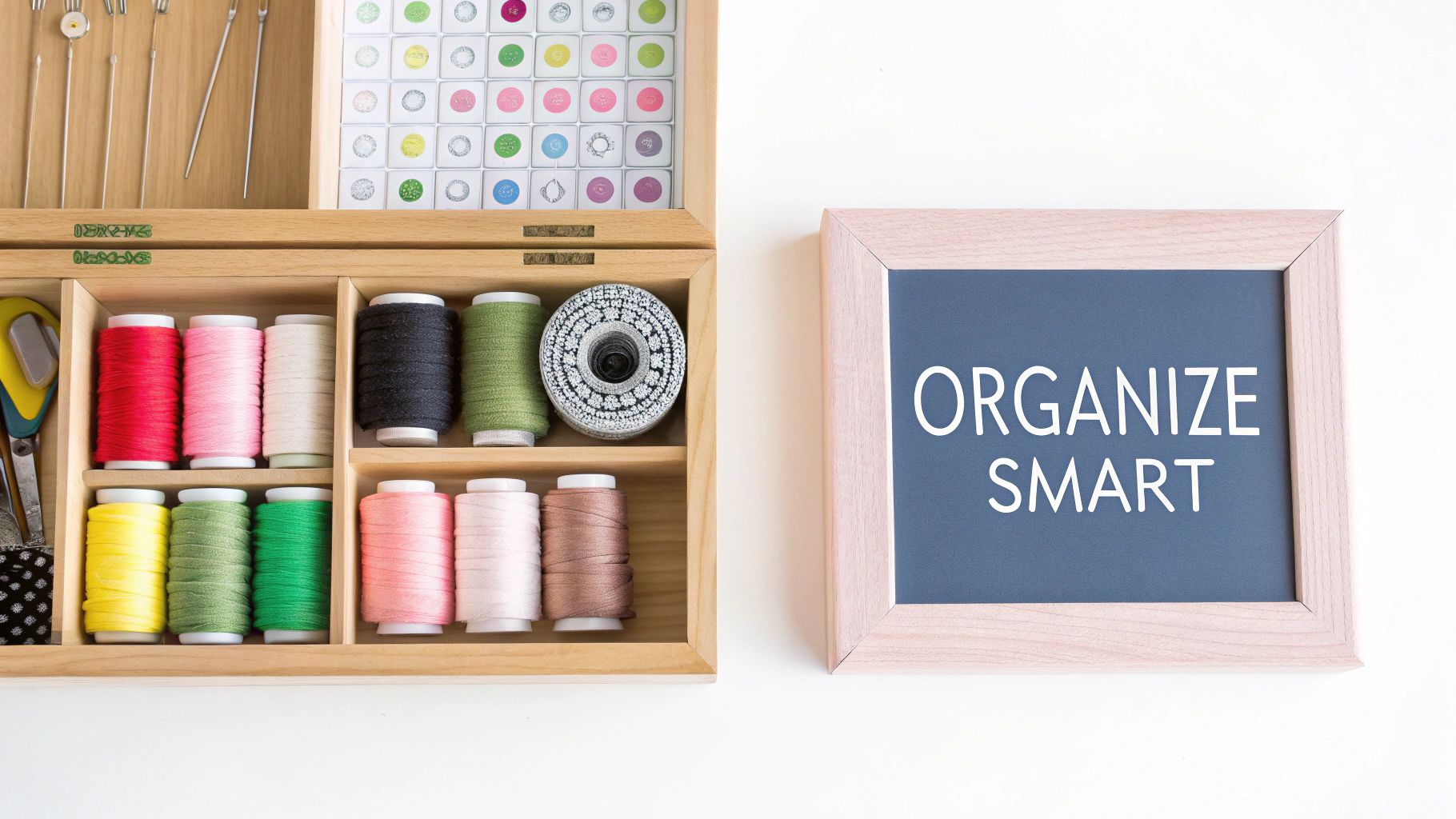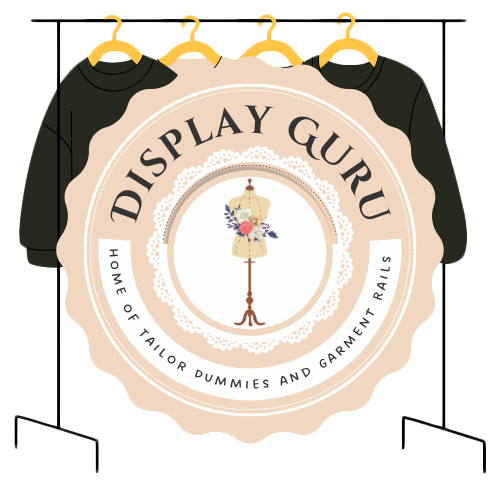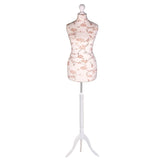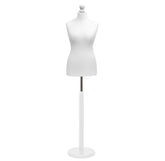wooden sewing box: Choose, Organize & Care Tips
In an age of plastic tubs and disposable bags, the traditional wooden sewing box still holds a special place in the heart of any crafter. It's so much more than just a container; it’s a beautifully crafted, highly practical command centre for all your sewing projects. This classic organiser isn’t just about storage—it’s about connecting with a long history of craftsmanship while giving your tools the protection and order they deserve.
Why a Wooden Sewing Box Is Still Essential for Crafters

Of course, modern storage has its uses, but a wooden sewing box brings together practicality and inspiration in a way that plastic alternatives just can't. Think of it like this: a plastic tub is a filing cabinet, but a wooden box is a handcrafted oak desk. Both get the job done, but one of them elevates your entire workspace and makes the creative process feel special.
A well-made wooden box is designed to last a lifetime, often becoming a cherished heirloom that carries stories from one generation to the next. That inherent sturdiness is also key for protecting your tools. Sharp scissors and delicate needles are kept safe from damage, moisture, and dust far better than they would be in a flimsy bag.
More Than Just Storage
Beyond its good looks and durability, the design of a wooden sewing box is pure efficiency. Everything about it, from the clever cantilever trays that swing open to reveal their contents, to the dedicated compartments and built-in pin cushions, has been designed around a crafter’s needs. This smart layout gives you a clear, at-a-glance overview of your supplies, meaning you spend less time rummaging for the right thread and more time actually sewing.
This kind of built-in organisation brings a welcome sense of calm and order to your creative corner. A tidy workspace often inspires a tidy mind, letting your creativity flow without the distraction of clutter.
A wooden sewing box is not just a tool but a partner in your craft. It holds the potential of every future project within its sturdy walls, encouraging discipline and inspiring creativity through its timeless design and reliable function.
Ultimately, choosing a wooden sewing box is a nod to quality and tradition. For someone just starting out, it lays the groundwork for a lifelong passion. For a seasoned pro, it’s a dependable workhorse that respects the artistry of their trade. A well-organised box is the first step towards a successful project, and you can find more ideas in our guide to designing the perfect sewing room setup.
The Craftsmanship Behind a Quality Sewing Box
There’s a world of difference between a basic plastic tub and a true heirloom wooden sewing box. It’s all in the craftsmanship. A well-made box isn't just about storage; it’s a beautifully designed tool, a piece of art that’s as much a part of your craft as your favourite scissors. And it all starts with the wood.
Think about it – sturdy oak gives you incredible durability and a lovely, pronounced grain, perfect for a box that will see daily action. Pine offers a lighter, more rustic feel and is often a bit kinder on the wallet. Then you have elegant mahogany, with its deep, rich colour that just whispers classic luxury. Each type of wood gives the finished box its own unique character, weight, and even a faint, pleasant scent.
What to Look for in Superior Construction
Beyond the type of wood, how the box is put together is what really matters. For joining the corners, nothing beats the traditional dovetail joint. You'll recognise it by the interlocking "pins" and "tails" of wood. This technique creates an incredibly strong bond that stops the box from being pulled apart over time, so it won’t warp or weaken even after years of use. Seeing dovetail joints is a sure sign that the maker built it to last.
The hardware is another tell-tale sign of quality. Are the hinges, latches, and handles made of solid brass or steel? They should feel substantial and operate smoothly. Flimsy, cheap hardware is almost always the first thing to break on a poorly made box.
Designs That Inspire and Organise
The internal layout is where a wooden sewing box really proves its worth. These designs have been refined over generations to perfectly suit a crafter’s needs. You’ll generally find two main styles:
- Cantilever Boxes: These are ingenious. The tiered compartments swing outwards and upwards when you open the lid, revealing everything at once. No more digging around! They’re brilliant for anyone who needs to grab different tools and notions quickly.
- Chest-Style Boxes: Simple, classic, and elegant. These often come with removable trays stacked inside. They’re a great choice if you like to keep your supplies organised into distinct, separate categories.
These designs have a fascinating history. For instance, the craftsmanship behind UK wooden sewing boxes in the 18th and 19th centuries was exceptional, showcasing amazing regional skill. Artisans used fine woods like mahogany and pine, often with detailed veneering using materials like tortoiseshell and Tunbridge Ware marquetry. You can learn more about the incredible history of sewing box artisanship and its materials.
It's the thoughtful little details inside that take a sewing box from good to great. Keep an eye out for things like built-in pin cushions, dedicated spool holders to stop threads from becoming a tangled mess, and tiny lidded compartments for beads, buttons, and other small treasures.
In the end, all these elements work together to create a small, highly efficient workspace. The best boxes almost seem to anticipate what you need, giving every single tool a proper home. A well-designed sewing accessory box doesn't just keep you tidy; it genuinely streamlines your workflow, making your creative time that much more enjoyable. This kind of attention to detail is what makes a box an indispensable partner in your craft, not just a container.
How to Find Your Perfect Wooden Sewing Box
Choosing a wooden sewing box is a bit like picking a creative partner. The right one will see you through countless projects for years, so it pays to think carefully before you buy. Having a mental checklist of what to look for will help you find a box that perfectly fits both your workflow and your ever-growing collection of supplies.
First things first, be honest about what you actually need. Take a good look at the materials you have now, and think about how your collection might expand in the future. If you're just starting out, a small, simple chest could be all you need. But if you’re a seasoned tailor, you'll likely want a large, multi-tiered cantilever box to handle a serious stash of threads, fabrics, and notions. Don't just think about how much it holds—think about how you get to it. If you’re constantly juggling tasks, a design that opens up to display everything at once will save you a world of frustration compared to one where you have to dig through stacked trays.
Understanding Materials and Build Quality
Next, get a feel for the materials and construction. A box crafted from solid oak or mahogany isn't just a purchase; it's an investment that could become an heirloom. On the other hand, plywood or veneered boxes are generally lighter on the wallet and easier to carry, but they may not stand up to decades of heavy use.
Always give the hardware a thorough inspection. The hinges, latches, and handles are the bits that tend to give out first.
- Hinges: Make sure they're fastened securely. The lid should open smoothly without any sticking or wobbling.
- Latches: Check that the latch clicks shut firmly and lines up properly. A weak latch is just asking for a spill.
- Handles: The handle needs to feel comfortable in your hand and, most importantly, be strong enough to support the box when it’s fully loaded.
Your personal style—be it Modern, Traditional, or Vintage—is a great starting point for narrowing down the options and finding a design that feels right for you.

Buying New Versus Vintage
Deciding between a new or vintage wooden sewing box really comes down to what you value most. A brand-new box offers that fresh-out-of-the-workshop perfection and modern features, whereas a vintage piece brings a story, unique character, and a tangible link to the past.
To help you decide, here's a quick comparison of what to expect from each.
New vs. Vintage Wooden Sewing Box Comparison
| Consideration | New Wooden Sewing Box | Vintage/Antique Wooden Sewing Box |
|---|---|---|
| Condition | Pristine, no signs of wear. Ready to use immediately. | Varies greatly. May have scratches, dents, or patina that adds to its character. |
| Durability | Built with modern techniques, but quality can vary. Solid wood is best. | Often made from solid hardwoods with time-tested joinery. Proven to last. |
| Functionality | May include modern features like customisable dividers or specialised compartments. | Traditional layouts that have worked for generations. Less likely to be customisable. |
| Potential Issues | Lower-cost models may use cheaper materials (MDF, veneers) that don't age well. | Check for woodworm, warping, musty smells (dampness), or weak repairs. |
| Aesthetics & Charm | Clean, modern, or classic designs. A blank slate for you to make your own. | Unique, one-of-a-kind character. A piece of history with a story to tell. |
| Cost | Wide range of prices, from affordable starter boxes to high-end, artisan-made pieces. | Price depends on age, rarity, condition, and craftsmanship. Can be a bargain or a splurge. |
Ultimately, there's no right or wrong answer. It’s about finding the box that resonates with you.
When you're looking at a vintage or antique box, be sure to look beyond its surface charm. Inspect it carefully for any signs of woodworm, warping from moisture, or old repairs that might affect its structural integrity. A faint musty smell is often a tell-tale sign of past dampness.
A well-chosen antique can be a stunning centrepiece for your craft space, but you need to know it's built to last. For more ideas on getting everything in order once you've found your perfect container, our guide on the ideal sewing organizer box has plenty of practical tips.
Whether new or old, the perfect box is the one that feels right in your hands and inspires you to create every time you lift the lid.
The Enduring Legacy of the Sewing Box
A wooden sewing box is so much more than a simple container for needles and thread. It's a small, beautifully crafted piece of history—a tangible link to the generations of makers who came before us. These boxes connect us to a past where needlework wasn't just a hobby but an essential, highly respected skill woven into the very fabric of daily life.
This connection to the past is especially evident in British domestic history. Here, the sewing box grew from a purely functional item into something deeply personal. Through the 18th and 19th centuries, as sewing became a cornerstone of a woman's education and social identity, the boxes that held her tools became more elaborate and meaningful. They were often true status symbols, exquisitely decorated and given pride of place in the home.
A Reflection of Social and Artistic Change
The golden age for these treasured objects began in the late Georgian era and truly blossomed throughout the Victorian period. The wooden sewing box holds a special place in British history, especially from the late 18th century onwards, mirroring both social customs and artistic traditions of the time.
Starting around the 1770s, these boxes became increasingly popular, particularly among Georgian ladies who spent a great deal of time on sewing and embroidery. They weren't just practical; they were highly personalised and often decorated to reflect the owner’s individual taste. In fact, some were even crafted by the ladies themselves. By the mid-1800s, the industrial revolution brought simpler, mass-produced models, but bespoke wooden boxes remained prized possessions. You can explore a wonderful collection of these beautifully preserved historical sewing boxes to see the craftsmanship for yourself.
The designs were also shaped by what was happening in the wider world. The growth of global trade introduced new and exotic woods, along with materials like ivory and mother-of-pearl, which were used for stunningly intricate inlays. Later on, design movements like Arts and Crafts pushed back against mass production, championing a return to traditional handiwork and simpler forms that let the natural beauty of the wood shine through.
From Utility to Heirloom
Every antique wooden sewing box has a story to tell. It hints at the life of its owner, the projects it helped create, and the world it once inhabited. These weren't throwaway items; they were cherished possessions, cared for and passed down from mother to daughter.
They were containers not just for tools, but for skills, stories, and memories. Owning one today connects you directly to this long, unbroken chain of creativity and tradition.
This is what makes a wooden sewing box so special. When you lift the lid, you’re not just reaching for your supplies—you’re taking part in a rich cultural heritage. It’s a quiet reminder that the simple act of mending a seam or creating something new is part of a tradition that has shaped homes and lives for centuries.
Smart Ways to Organise Your Sewing Box

A well-organised wooden sewing box is so much more than just a tidy space. It’s your personal, high-efficiency workstation, ready to save you precious time and cut out the frustration of hunting for that one specific item. When you arrange your supplies with a bit of thought, you turn a simple storage container into a true partner in your creative process, ensuring every tool is at your fingertips the moment inspiration strikes.
Think of your box like a perfectly arranged workshop. Those top trays are your prime real estate, the ideal spot for all the tools you reach for constantly. Pop your favourite scissors, seam ripper, thimble, and measuring tape right there for instant access. It's a simple change that stops you from having to dig through layers of supplies, keeping your workflow smooth and uninterrupted.
The deeper compartments are perfect for things you use a little less often, or for grouping items by project. A real game-changer is bundling threads, buttons, and zips for your next few projects into small bags or containers. That way, when you’re ready to start, everything you need is already gathered and waiting for you.
Maximising Your Internal Space
To really make your sewing box work for you, it’s all about thinking vertically and using dividers. While many boxes have built-in sections, you can easily add your own small containers or trays to categorise your notions even further. This kind of detailed organisation makes finding tiny items like beads or specific needle sizes a breeze.
Here are a few practical strategies to take your organisation to the next level:
- Magnetic Strips: Stick a small, self-adhesive magnetic strip to the inside of the lid or a tray wall. It’s absolutely brilliant for keeping pins and needles secure and stops them from getting lost in the shuffle.
- Colour-Coded Sorting: Use small, clear containers or even tiny resealable bags to sort your buttons, beads, and snaps by colour and size. This turns matching notions to your fabric into a quick, visual task.
- Thread Bobbins: Wind any loose threads onto cardboard or plastic bobbins. Not only does this prevent those maddening tangles, but it also makes it much easier to see your entire colour inventory at a glance.
A well-organised sewing box reflects a clear creative mind. When every item has a designated home, you free up mental energy to focus on your craft, not on searching for a misplaced tool.
Going beyond just placing items in your wooden sewing box is where the magic happens. Mastering the art of organisation can completely transform your crafting experience. For a deep dive, you can learn how to organize craft supplies like a pro.
These small adjustments can have a huge impact, turning your box into a perfectly streamlined kit. For more ideas on creating the ultimate organised crafting space, have a look at our detailed guide on choosing the best sewing organiser boxes.
Caring for Your Wooden Sewing Box
A well-made wooden sewing box is more than just a place to keep your supplies; it's a piece of craftsmanship that, with the right care, can last a lifetime and even be passed down through generations. Keeping it in top condition isn't complicated, but it does require a bit of consistent attention to preserve its beauty and function.
The first step is simple: regular dusting. Grab a soft, dry microfibre cloth and give all the surfaces a gentle wipe-down, not forgetting the inside compartments. It’s best to avoid feather dusters, as they tend to just push dust around and can easily snag on hinges, latches, or any detailed carving.
For a more thorough clean, particularly on a box with a varnish or lacquer finish, you’ll want to be careful with moisture. Dampen a soft cloth with water and just a tiny bit of mild soap. Make sure to wring it out until it’s barely damp, then wipe the surface gently. The crucial part is to immediately follow up with a clean, dry cloth to make sure no moisture is left behind. Water is the natural enemy of wood.
Polishing and Long-Term Preservation
Every now and then, a good polish will bring back that beautiful lustre and add a protective layer. What you use really depends on the finish of your box.
- For Wax Finishes: A high-quality paste wax is your best friend. Apply a small amount with a soft cloth, moving with the grain of the wood. Let it sit for a few minutes, then buff it to a lovely, soft sheen.
- For Oiled Finishes: You can refresh an oiled surface with a light coat of tung or linseed oil. Just be sure to wipe off any excess thoroughly to avoid it becoming sticky.
- For Varnished Finishes: A good commercial cream polish usually does the trick. A word of advice: always test any new product on a small, hidden spot first, just in case.
Beyond cleaning, think about where you keep your box. Direct sunlight can bleach the wood and dry it out over time, while placing it too close to a radiator or air vent can cause the wood to crack from the constant temperature changes.
The durability of wood has always been a prized quality. Between 1850 and 1900, British demand for exotic sewing boxes from India surged, partly because they were often made from strong, insect-proof sandalwood, ideal for protecting delicate tools. This highlights how proper care continues a long tradition of preservation.
If you're lucky enough to own an antique box, it’s worth learning how to safely clean antique wood to protect its unique patina and history. And remember, creating the right environment is key, so have a look at our guide on choosing the best storage units for crafts to complement your setup.
Got Questions About Wooden Sewing Boxes? We Have Answers
Whether you’ve just inherited a vintage sewing box or are thinking of buying your first one, you’re bound to have a few questions. These classic organisers are steeped in history, and getting to grips with their materials and care is key to making them last.
Think of it like this: a little bit of know-how goes a long way. Understanding what makes a great sewing box helps you choose one that will be your trusted companion for years, not just a temporary fix.
What’s the Best Wood for a Sewing Box?
The right wood for a sewing box really comes down to a trade-off between stunning looks and sheer durability. For a piece you want to pass down through the family, you can’t go wrong with a classic hardwood.
- Oak and Mahogany: These are the heavyweights. They're incredibly strong, with a dense grain that resists warping over time. A box made from either of these feels substantial and is built to withstand the rigours of daily use.
- Pine: If you're looking for something a bit lighter on the wallet and easier to carry around, pine is a fantastic choice. It's a softer wood but still perfectly functional for an everyday sewing box.
- Sandalwood: This one’s a bit special. Historically popular in places like India, sandalwood has a beautiful scent and, more importantly, it's a natural insect repellent. This offers built-in protection for your precious threads and fabrics.
How Should I Clean an Old Wooden Sewing Box?
Cleaning a vintage box is all about being gentle – you want to preserve its story, not scrub it away. The golden rule is to start with the mildest cleaning method possible.
First, give it a good dusting with a soft, dry microfibre cloth to get rid of any loose debris. If it’s still a bit grimy, dampen a cloth with a very weak mix of mild soap and water. Wipe the surface gently, and then immediately dry it thoroughly with a fresh, clean cloth. If you're tempted to use a commercial wood cleaner, always test it on a small, hidden spot first to see how the old finish reacts.
Never, ever reach for harsh chemical sprays or abrasive sponges. They can easily strip the original varnish, ruin the aged patina, or damage any delicate details that give an antique wooden sewing box its charm and value.
At Display Guru, we know that every creator needs the right tools to bring their vision to life. Explore our range of professional-grade tailor's dummies and smart organisational solutions to build the sewing studio you've always wanted.








